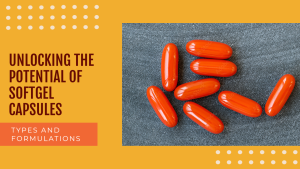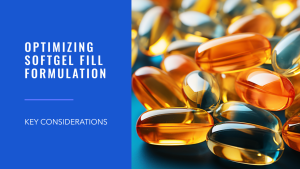The Art Of Soft Gelatin Capsule Shells: A Look Into The Manufacturing Process

Learn the step-by-step process of gelatin production, from raw material preparation to the final product. This guide covers both the hot melt and cold melt methods, equipment needed, and common issues encountered in the manufacturing process.
Production of Gelatin
The production of gelatin for softgel capsules involves a meticulous process that transforms raw collagen from animal sources into a usable gel. This transformation occurs in a specialized environment using specific equipment to ensure the quality and consistency of the final product. Let’s delve into the detailed gelatin production process, highlighting the methods and equipment used.
Manufacturing Process Overview
The manufacturing process for gelatin takes place inside a sizeable special tank called a reactor or melter. This tank is a heatable double-jacketed stainless steel vessel with a high-torque turbine mixer and paddle blades inside. The heat source can be steam, hot water, or electricity.
There are two basic compounding methods used for the manufacturing of gelatin solution:
- Hot Melt Method
- Cold Melt Method
Both methods are equally effective, and the choice depends on the manufacturer’s preference. Either method takes about 1 – 1h30 hours to transition the gelatin to hot melt and vacuum to create a batch of the hot gelatin liquid, resembling thick pancake syrup. Before unloading the melter, it is essential to check the viscosity and ensure no air bubbles, foam, or suspended gelatin particles remain in the solution.
Measuring Viscosity
Viscosity, a critical quality attribute, is measured using a viscometer. Because gelatin is thick, viscometers with rotating discs are preferred over those with glass tubes. For softgels, gelatin with a viscosity range of 11.000 ± 2.000 centipoises (measuring with spindle 4 apparatus, speed 10 rpm, measurement time 30 seconds, Torque above 50%, temperature 60º C ± 2° C) is ideal, depending on the type and formulation of the gelatin.
Practical Viscosity Check
Operators often check viscosity using a practical method (this indicates the correct viscosity):
- Take a small sample with a paddle.
- Dipping a finger into the gelatin.
- Pull the finger away to see if the gelatin “strings” to a distance of 4-5 inches.
Seasoning the Gelatin
Once ready, the gelatin is transferred to a heated storage tank, known as a receiver, to “season” for a minimum of 3 hours and up to 96 hours. This process removes the air, allows the gelatin to cool, and sets it to an ambient temperature of 65-70 °C. Maintaining a uniform temperature is crucial for successful encapsulation.
Adding Color
Color can be added to the gelatin in two ways:
- During the initial melting process.
- After the gelatin has been prepared, usually in the mobile gelatin receiver with an airless mixer.
Tips:
- Remember that the dye solution must be transferred to the gelatin tank through an 80 mesh to mitigate possible lumps or dirt that could impact the encapsulation process later.
- At this stage, the water content in the gelatin solution is typically between 30% and 45%, which will reduce to less than 10% in the final product.
Hot Melt Method
- Weigh and Charge: Measure water and glycerin, then load them into the melter.
- Heat: Heat the water and glycerin mixture to 70°C – 80°C.
- Add Gelatin: Weigh and add gelatin to the melter, increasing the mixer speed moderately.
- Mix and Vacuum: Close the melter lid, start mixing, and initiate the vacuum. Gradually increase the vacuum to remove air bubbles.
- Check Gel: After mixing, check the gelatin texture and viscosity. If clear and within the required viscosity range, proceed.
- Transfer: Discharge the melter into gelatin receivers, ensuring proper weights and temperatures are recorded.
Cold Melt Method
- Weigh and Charge: Measure and add water and glycerin to the melter, starting the mixer at a slow speed.
- Add Gelatin: Weigh and add gelatin, increasing the mixer speed as necessary.
- Heat: Close the melter lid and start heating to maintain a temperature range of 70°C – 80°C.
- Mix and Vacuum: Initiate the vacuum and gradually increase it to remove air bubbles.
- Check Gel: Ensure the gel is clear and free of air bubbles, then add colorants if needed.
- Transfer: Discharge the melter into gelatin receivers, recording weights and temperatures.
Equipment
- Melter: A stainless steel, jacketed tank with a high-speed motor and low-shear agitator, capable of heating to 70-80°C and containing a vacuum.
- Vacuum Pump: Typically water-sealed and powerful enough to pull a vacuum quickly.
- Heating System: Can be electrical, hot water, or low-pressure steam.
- Air Pressure: Low-pressure air (3-12 PSI) helps transfer the gelatin mass.
- Transfer Tanks: Mobile tanks made of 316 stainless steel with built-in heating systems and controls, maintaining temperatures of 60-75°C.
- Electrical Outlets: Keeping the gel mass warm in the transfer tanks and encapsulation machines is necessary.
- Scales: These are used to weigh raw materials and ensure accurate measurements.
- Mixers/Mills: For mixing colorants, flavorants, and actives into the gel mass.
- Viscometer: To measure the viscosity of the gel mass.
- Thermometer: Long-stemmed thermometers to maintain the gel mass at the specified temperature.
Raw Materials
- Gelatin: Sourced from reputable suppliers with a precise and uniform particle size.
- Glycerin: USP-grade glycerin for its purity.
- Water: Purified water, typically DI, RO, or bottled water.
- Colors: Water-soluble or dispersible colorants in powder, glycerin, or water form.
- Flavors or Actives: Non-reactive and non-volatile materials added at the end of gel mass production.
Gelatin Solution Preparation

The process is designed to produce a mass capable of making softgels with efficient mixing and reduced defects. The gel mass should be free of air or undissolved particles and within a specified viscosity range.
- Solution Preparation: The gelatin manufacturing process aims to produce a mass capable of making softgels with efficient mixing and reduced defects. The gel mass should be free of air or undissolved particles and within a specified viscosity range.
- Color Addition: Add colorant towards the end of gel mass production to ensure uniformity.
- Temperature Control: Maintain the gel mass at the specified temperature during the holding period.
- Holding Period: Allow the gel mass to cool before encapsulation to the melting temperature range.
- Stratification: Prevent stratification by mixing the gelatin mass using an airless mixer before encapsulation.
Common Problems Encountered
- Particulate in Gel Mass: Caused by poor quality gel, inadequate cleaning, or incomplete cooking. Solutions include filtering the gel mass, improving cleaning, and increasing process time and temperature.
- Gel Mass Too Thick: Caused by incorrect bloom strength, formula, temperature, or holding time. Solutions include adjusting the formula, increasing holding time, and checking heating elements.
- Gel Mass Too Thin: Caused by too much water or glycerin, incorrect gel type, or high temperature. Solutions include vacuuming out water, adjusting the formula, and maintaining the correct temperature.
- Air in Gel Mass: Caused by improper melting procedure, inadequate vacuum capability, or insufficient holding time. Solutions include improving the vacuum process, checking for leaks, and allowing more holding time.
Reclaim/Reuse Procedure for Gelatin from Netting
Reclaiming gelatin from netting can save costs. The process involves:
- Collecting clean netting.
- Melting the netting in a heated receiver.
- Removing oil that floats to the top.
- Mixing reclaimed gelatin with fresh gelatin batches.
- Limiting reclaimed gelatin to 20 % of a new batch.
Conclusion
Understanding the detailed process of gelatin production, the equipment required, and the common problems encountered is crucial for producing high-quality softgels. By following these meticulous steps and addressing issues promptly, manufacturers can ensure consistent and reliable gelatin shells for various applications.
Read the original text here
Source: Vitor Jacó Antraco and Sair Torregrosa, LinkedIn (70) The Art Of Soft Gelatin Capsule Shells: A Look Into The Manufacturing Process | LinkedIn
See the full article series:

- Optimizing Softgel Fill Formulation: Key Considerations
- The Ultimate Guide to Soft Gelatin Capsule Manufacturing




